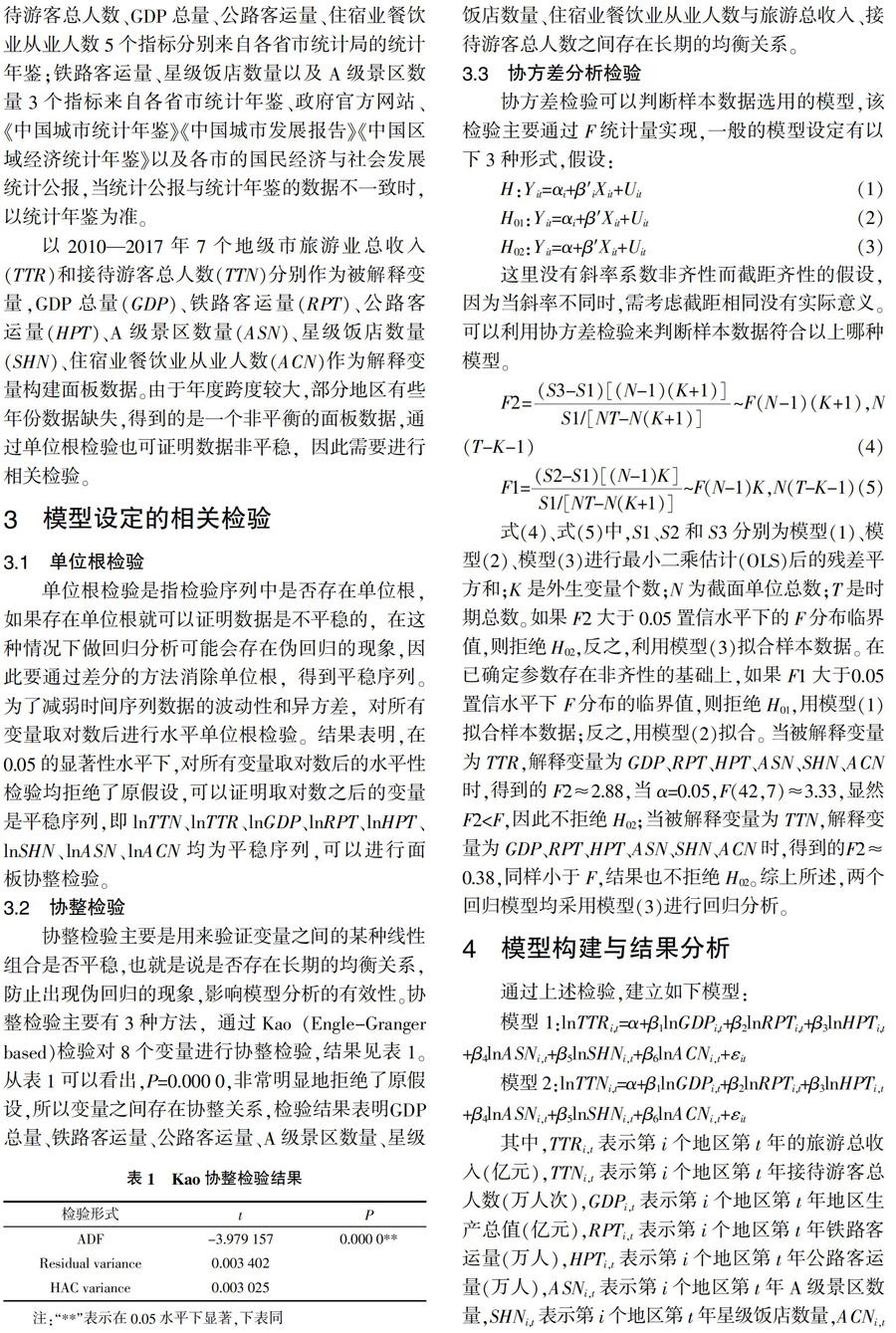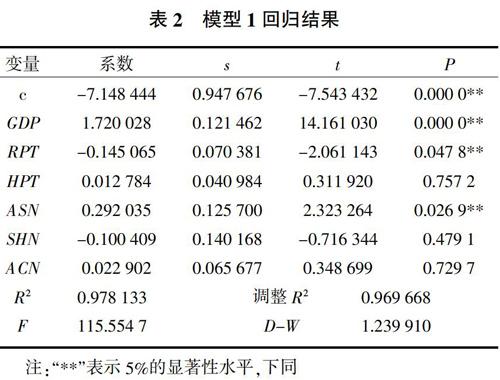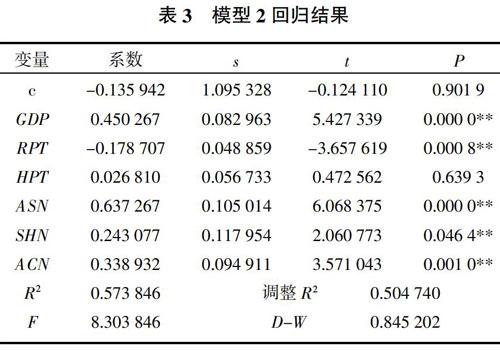高铁速度下中小城市旅游发展的困境与策略选择
2019-11-12柴海燕任秋颖王璐
柴海燕 任秋颖 王璐



摘要:选取武广高铁沿线7个中小城市作为研究对象,从经济发展水平、交通区位条件、旅游资源禀赋、旅游接待能力4个方面建立了影响旅游经济发展水平的指标体系,构建计量经济学面板数据,通过混合回归模型研究发现,旅游经济发展水平与地区经济发展水平、旅游资源丰富程度、旅游目的地接待能力呈正相关,与铁路客运量呈负相关,即“廊道效应”并未使武广高铁沿线中小城市旅游发展从中受益。提出应从提高中小城市旅游吸引力入手,与中心城市合作共赢,将高铁带来的可达性转换为实际的旅游利润。
关键词:武广高铁;旅游经济;廊道效应;策略
中图分类号:F59 文献标识码:A
文章编号:0439-8114(2019)18-0158-05
DOI:10.14088/j.cnki.issn0439-8114.2019.18.039 开放科学(资源服务)标识码(OSID):
The dilemma and strategic choice of tourism development in small and medium-sized cities under the speed of high speed rail
CHAI Hai-yan,REN Qiu-ying,WANG Lu
(School of Economics and Management,China University of Geosciences (Wuhan),Wuhan 430074,China)
Abstract: The small and medium-sized cities along the Wuhan-Guangzhou high-speed railway were selected as research objects. From the four aspects of economic development level, transportation location conditions, tourism resource endowment and tourism reception capacity, an index system was established to influence the development level of tourism economy, and econometric panel data was constructed. The study found that the level of tourism economic development is positively correlated with the level of regional economic development, the richness of tourism resources, and the reception capacity of tourist destinations, and is negatively correlated with the passenger volume of railways, that is, the “corridor effect” makes the tourism development of small and medium-sized cities along the Wuhan-Guangzhou high-speed railway did not benefit from it. It is suggested that we should start from improving the tourism attractiveness of small and medium-sized cities, and cooperate with the central cities to achieve win-win results, and convert the accessibility brought by high-speed rail into actual tourism profits.
Key words: Wuhan-Guangzhou high-speed railway; tourism economy; corridor; tactics
交通是旅游的生命线,直接影响旅游者的出游距离和目的地的选择,最终影响旅游业发展程度。近年来,高铁的出现给旅游业带来了巨大的变化。高铁旅游产生的“时空压缩”效应缩短了游客的旅行时间,使旅游者能够在较短的时间到达旅游目的地,同时扩大了游客出游半径,提高了旅游目的地之间的可达性,真正实现“快旅慢游”[1]。可达性是目的地旅游经济发展的必要前提。近年来高速铁路的建设和开通助推中国旅游经济提速至2.0时代。但高速铁路的发展对沿线中小城市的旅游发展是“廊道效应”还是“聚集效应”还值得探讨。
高铁的开通也使沿线城市的旅游业获益。来自意大利、英国、西班牙、日本及中国学者的研究都表明,随着城市可达性的提高,沿线城市的商务、休闲旅游获得大发展,旅游收入随之提高,就业岗位增多[2-6],高铁沿线旅游经济带和环中心城市旅游经济圈呼之欲出。但国外相关研究也表明,高铁的开通在促进核心城市旅游集聚效应的同时,也进一步扩大了中小城市的“廊道效应”。中国高铁的运行极大提升了沿线中小城市的可达性,按常理推测,这些城市的游客量和旅游总收入会随之水涨船高。但从数据上来看,这些城市的旅游人次及总收入并未获得快速提升。中国高铁运行对沿线中小城市旅游的带动作用是否因旅游吸引力不足而客观上促成了“廊道效應”的加剧,高铁开通对沿线中小城市旅游发展的贡献率如果确实存在“廊道效应”加剧的现象,中小城市旅游管理者该如何应对等问题都值得探讨。因此,以武广高铁为例,选取沿线7个地级市为研究对象,基于面板数据剖析该现象,以期为高铁对中小城市旅游发展的影响提供实证借鉴。
[10] FABER B.Trade integration,market size,and industrialization:Evidence from China's national trunk highway system[J].The review of economic studies,2014,81:1046-1070.
[11] QIN Y.‘No county left behind? The distributional impact of high-speed rail upgrades in China[J].Journal of economic geography,2017,17(3):489-520.
[12] DIAO M. Does growth follow the rail?The potential impact of high-speed rail on the economic geography of China[J].Transportation research part A:Policy and practice,2018,113:279-290.
[13] XIAO K,CHEN H Q,HONG Y M,et al. Do China's high-speed-rail projects promote local economy?——New evidence from a panel data approach[J].China economic review,2017,44:203-226.
[14] 王凯妮,邓小鹏.高铁能促进地级市旅游经济的增长吗?——以京沪高铁为例[J].经济论坛,2018(12):43-48.
[15] 鲁万波,贾 婧.高速铁路、城市发展与区域经济发展不平等
——来自中国的经验数据[J].华东经济管理,2018,32(2):5-14.
[16] 宋文杰,朱 青,朱月梅,等.高铁对不同规模城市发展的影響[J].经济地理,2015,35(10):57-63.
[17] MASSIDDA C,ETZO I.The determinants of Italian domestic tourism:A panel data analysis[J].Tourism management,2012, 33(3):603-610.
[18] ALBALATE D,FAGEDA X.High speed rail and tourism:Empirical evidence from Spain[J].Transportation research part A:Policy and practice,2016,85:174-185.
[19] ALBALATE D,CAMPOS J,JIMENEZ J L.Tourism and high speed rail in Spain:Does the AVE increase local visitors?[J].Annals of tourism research,2017,65:71-82.
[20] 甘巧林.旅游大省旅游业发展实力比较——兼析广东旅游业的发展实力[J].旅游学刊,2003(2):15-18.
[21] GAO Y Y,SU W,WANG K N. Does high-speed rail boost tourism growth?New evidence from China[J].Tourism management,2019,72:220-231.
[22] 万文平.高速铁路对沿线非枢纽城市旅游经济影响研究[D].北京:北京第二外国语学院,2013.
[23] 王 璐.武广高铁对其湖南沿线城市旅游经济的影响[D].湖南湘潭:湘潭大学,2016.
[24] 何仁伟,李光勤,曹建华.酒香真的不怕巷子深吗?——基于国家级风景名胜区的区位选择问题研究[J].旅游学刊,2018,33(9):94-107.
